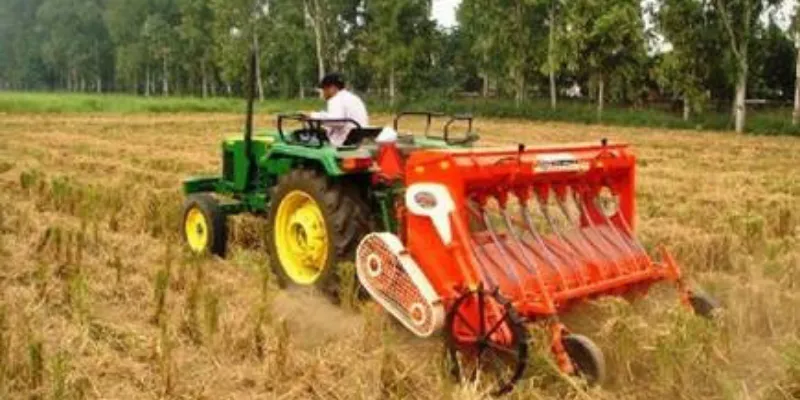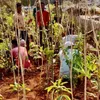Here's how these two 17-year-old girls are fighting Delhi's infamous air pollution
Ketaki Tyagi and Shruti Sood, students of Class 12, started a crowdfunding campaign to buy machines that can convert stubble into fertiliser to ensure that the harmful practice of crop residue burning is eliminated. They raised Rs 3.5 lakh and have given away three machines to farmers till now.
Winter is coming, and it is sure to bring a huge increase in Delhi's air pollution level. Vehicular pollution is a big reason, but crop residue burning is also seen as a major contributor to the air's toxic quality.
According to a report by the Centre-run System of Air Quality Forecasting and Research (SAFAR), stubble burning in Punjab and Haryana contributed 32 percent to Delhi's air pollution last year. While many of us might put on a mask or avoid stepping out to escape the pollution, there are a few who are going the extra mile to look for solutions to this pervasive problem.

Shruti (extreme right) and Ketaki (second from right) with women farmers in Haryana.
Ketaki Tyagi and Shruti Sood, 17-year-old students of Class 12, have taken it upon themselves to combat air pollution in the region by starting a crowdfunding campaign called ‘Happy Seeder, Happy Lungs’.
The two Delhi-based girls have managed to raise over Rs 3.5 lakh in three months in 2018 through this initiative. They used the money to buy machines that can convert stubble into fertiliser, and distributed them to farmers in Jhajjar, Haryana. Apart from providing an eco-friendly solution to eliminate crop residue, the two students also conducted awareness sessions and educated farmers about the harmful effects of stubble burning.

An awareness session organised by Ketaki and Shruti in Haryana.
“I and Shruti have received positive responses from several farmers, and they are all set to use the Happy Seeder machine in the upcoming harvest season. If this method is used on a large scale, I am sure the pollution levels will come down to a great extent,” says Ketaki to Social Story.
How it all started
Ketaki and Shruti grew up in the same residential colony in Delhi. Though they were studying in different schools – Ketaki at Sanskriti School, and Shruti at British School in Chanakyapuri – they met often and became good friends.
Ketaki has an undying love for the game of football and represented India in the Under-14 tournament, while Shruti is a competitive swimmer. These 17-year-olds are just like any other teenagers - curious, fun loving, and enthusiastic. The only difference is the that they did not want to complain about problems; they wanted to help find a solution.

Ketaki and Shruti are working to create awareness about the harm stubble burning causes to the environment.
“Both of us used to have many conversations surrounding the bad quality of air in Delhi. As we delved deeper, we got to know that one of the main causes was stubble burning. This is when we decided to take action. We started looking for solutions, and after a few days, we came across the Happy Seeder device. But since the machine was expensive, we decided to raise funds, buy, and distribute to farmers,” Shruti says.
Putting an end to stubble burning
In 2018, Ketaki and Shruti initiated a crowdfunding campaign on the Ketto platform to fund the purchase of three machines. The duo saw the Happy Seeder technology as a way to tackle the stubble burning problem during winters.
The machine, developed by a set of engineers from CSIRO Griffith at Punjab Agricultural University in 2001, cuts off crop residue from the soil, mulches it, and even sows new seeds in its place. All farmers had to do was mount the device on their tractor, and drive.
“During our research, we found the intervention to be very effective. Not only did the machine offer an efficient and sustainable way to root out the burning of stubble, but also ensured timely sowing of wheat crops, thereby eliminating the need to irrigate soil in the initial stage. Besides, farmers also realised that since the machine was capable of converting residue to mulch, the same could be used as a fertiliser for crops,” Ketaki says.

The Happy Seeders machine removes crop residue from the soil and mulches it, eliminating the need to burn the stubble.
However, one of the main setbacks was the price of the machine. Several farmers could not afford to pay Rs 1.7 lakh for a machine. Besides, the use of Happy Seeders yielded only a small profit as compared to conventional methods.
For instance, the average yield of wheat on plots that used the machine was 43.3 quintals/hectare (ha), while the average yield using conventional methods was almost the same at 43.8 quintals/ha. The average cost of preparing the field for sowing using Happy Seeders was Rs 6,225/ha. On the other hand, it cost Rs 7,288/ha when traditional methods were applied. Thus, farmers could effectively save only Rs 1,000/ha.
“We figured that the best way to overcome these constraints was to start giving away the Happy Seeder machines to farmers for free, and convince them to adopt the technology for the benefit of the environment. And that is exactly what we did,” Shruti says.
Paving the way for clean air
Ketaki and Shruti managed to raise around Rs 3.5 lakh out of the Rs 5 lakh they had pitched for through crowdsourcing. They used this money to buy three Happy Seeder machines from multiple vendors.
“We conducted a lot of research before deciding to give away the machines to the gram sanghatan of Matenhail Block in Jhajjar, Haryana, comprising a total of 53 villages. Most farmers in these villages turned out to be women. We introduced the mechanism of leasing out the machines for a specific set of days by paying small amounts, and the response we received from the farmers was phenomenal,” Ketaki says.

The Happy Seeders machines were given away to the gram sangathan at Matenhail Block, Jhajjar, Haryana.
The two girls also conducted awareness sessions across the villages about the pollution caused due to stubble burning, and how the Happy Seeder machine could help prevent it. Their efforts eventually bore fruit, and today Ketaki and Shruti have made over 3,600 acres of land free of stubble burning.
“Initially, we found it difficult to manage our time. We had to both on academics and manage the campaign. Our work involved intensive research, followups, and travel. However, I feel it was all worth it considering the larger cause. We are planning to raise another round of funds this year to buy more machines,” Shruti says.
Ketaki wants to become a psychologist in the future, while Shruti is dreaming of pursuing environmental engineering. However, the duo plans to continue their endeavour. Theyr ultimate aim: to eliminate the practice of stubble burning across the country.
(Edited by Megha Reddy)










